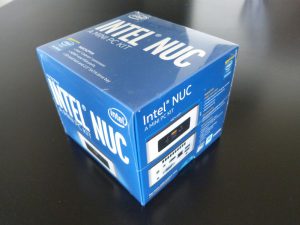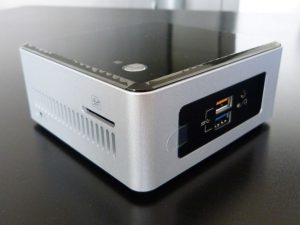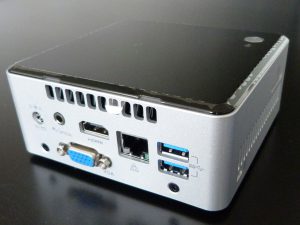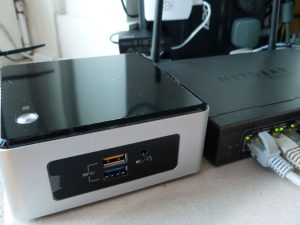With the untimely demise of the Gigabyte Brix, I needed to find another solution for a small machine that would handle all web traffic to my sites. My fingers got burnt by using Gigabyte so this time I decided to track down an Intel marketed machine, they were the first to pioneer the net-top device and so commanded a premium over other manufacturers.
Price always at the forefront, I picked up an Intel NUC5CPYH, at £120 for a barebones system it featured an Intel Celeron 2.16Ghz processor at the helm, with the same single DDR3L slot and support for a 2.5 inch HDD/SDD as the Brix, which I recovered from the deceased system.

Being nearly twice the price as the Gigabyte model, I was hoping that the cost brought better design and reliability. From the outside view there was an extra USB port, bringing the total to four over the Brix’s three, but opposed to the Brix’ single USB 3.0 standard port and 2 at USB 2.0, all the Intel’s were of the USB 3.0 variety, with one of the front ports doubling as a charge port. Also the Intel featured over the Brix a combo 7.1 channel audio optical out via a 3.5mm jack and an infrared sensor at the front, which makes it more attractive as a home media player but alas useless for my intended application.


Opening up, the four screws were recessed within the rubber feet of the case, a handy design that meant after untightening the feet could be used as makeshift thumbscrews. Getting inside, revealed a similar single board setup, with the empty RAM slot easily accessible. A mini PCI-e slot occupied by the combo Wireless / Bluetooth module, with neater cable management for the antennas. A curious look on the other side unearthed a fan on the heatsink, so this would not be a silent machine, but luckily fan settings can be tuned down in the BIOS. Cable for the 2.5Inch drive were fixed within the base, and as a better design the drive simply slid in to the connector and secured with two screws, but the metal holder over the other two drive screws would be enough to hold it in place.
Getting the machine operative, I recycled 4GB of Kingston Value RAM and an OCZ Trion 100 120GB SSD, then installed Windows Server 2012. For me a processor being labelled Celeron brings the stigma of being a slow and incapable processor, but on first impressions this proves much more competent then the Intel Atom E3825 1.33Ghz of the Gigabyte Brix. Plus, the inclusion of a 6Gbps channel for the SSD allows it to function at its intended speed and aid system performance.
Overall, first impressions are good for the Intel NUC, and setting up a new server being fresh in my mind made the whole operation smoother. While I would like a passive cooled system for a completely silent PC, the ability to stop the fan until absolutely necessary in BIOS gives peace of mind that it will be cooled, and SSD temps via the OCZ monitoring utility proves that effective cooling is achieved. Only time will tell if this is a viable machine for a web server.
